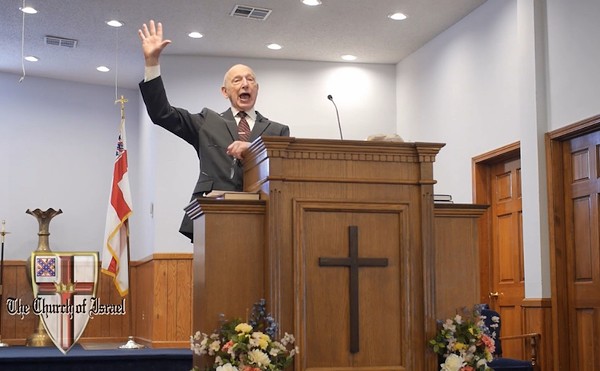The most charming B&Bs are those that are natural extensions of the neighborhoods surrounding them — and of their owners' personalities. Check and check at Casa Magnolia Bed & Breakfast, a 1906 Shaw neighborhood home that owners Lillabet Popp and Jordi Felix have spent more than a decade meticulously restoring. Perfect for out-of-towners and St. Louis staycationers alike, Casa Magnolia overlooks Tower Grove Park and offers some of the comfiest, cushiest rooms around. (Each has its own private bathroom.) Popp and Felix blend century-old beauty with present-day convenience — that explains the lovely antique collection, the library and the free WiFi). A deluxe breakfast is served every morning between 7:30 and 8 a.m., but no worries if you hit "snooze" five too many times; a continental option is available for sleepyheads. In the summer guests are welcome to enjoy breakfast by the pool. Just be sure to book your stay at least a week in advance: This gorgeous home-away-from-home is popular, and its three rooms get snapped up quickly.
Les Sterman retired from the East-West Gateway Council of Governments this past July, after 26 years as head of the region's planning and transportation agency. During his tenure at East-West Gateway, Sterman served as a chaperone of sorts, goading elected officials in Missouri and Illinois into sharing the sandbox we call "metro St. Louis." Sterman's influence helped spur the building of MetroLink and rein in the use of tax-increment financing, which can rob jobs and businesses from one local community to aid another. Sterman now heads the Southwestern Illinois Flood Prevention District — a massive governmental program to rebuild and improve Metro East levees. He also remains active with East-West Gateway in its Great Streets Initiative, which advocates for more pedestrian-friendly thoroughfares in St. Louis.
We regret due to lack of funding service to this category is suspended. (Photo.)
Joseph Marconnot, a truck driver descended from an old French family in Carondelet, slipped off this mortal coil in 1924. In his will he stipulated that he be embalmed in the manner of King Tut (whose tomb had only been discovered two years earlier), dressed in a tuxedo and laid to rest in a mausoleum with a glass door so visitors from all over the world could stop by and admire him. Because Marconnot had no wife or children to object, his wishes were carried out, and a granite mausoleum was built for him in Mount Olive Cemetery in Carondelet. Alas, years later the Archdiocese of St. Louis worried that vandals would break the glass door and requested that Marconnot's heirs replace it with one made of stainless steel. Now the Mount Olive Mummy is completely hidden from the public, and cemetery representatives say it's impossible to arrange a viewing. Still, the imagination is a powerful thing, and it's sort of delightful to wander through Mount Olive's pleasant rolling hills and know that a mummy lurks nearby. Also interred in Mount Olive are trumpeter Louis Jordan and Dick, who died in the 1849 cholera epidemic and was one of the few antebellum slaves whose master gave him a proper burial with a gravestone. Neither, as far as we know, was mummified.
The country road ahead: fairly straight and tree-lined, the wildlife area in your rear-view mirror. You know what lies ahead, but the kids in back don't. Nudge the gas a little more toward the floor — 55, 60, 65, don't want the tires to actually leave the ground. The road falls away and the wheels follow, the car floating on its suspension. You momentarily feel like Wile E. Coyote at the instant he realizes he's run out of mesa. Then you're in free-fall — you hear a delighted "wheee!" behind you. But the drop isn't that far, and up the other side you go. You're pulling some G's now. Well, maybe a G and a quarter, but still it glues your butt to the seat till you crest the far side of the dip. The car hugs the road, but you feel as though you're floating again, only the seat belt holding you down, your stomach a little higher in your gut than normal. The road flattens out, stretching toward the river and wine country. "Let's turn around and do it again!" Sure, why not.
On November 7, 2008, Teodora Petrova, a Bulgarian immigrant who spoke little English and had been in the country for less than two months, started a new $8-per-hour job at the MERS Goodwill in Glen Carbon, Illinois. As Petrova was sorting through donated clothes and shoes, she discovered a shoebox full of cash. She alerted her manager to the find, the story found its way onto TV news and a family stepped forward to claim the money — a cool $7,500, which had been hidden among a big batch of belongings donated after the death of a parent. The grateful family gave Petrova a reward for her selflessness; not to be outdone, an anonymous philanthropist wrote out a check for — you guessed it — $7,500. Once her fifteen minutes of fame ticked down (she made headlines even in her native country), Petrova invested her windfall to continue her education in America; she holds degrees from Bulgarian universities in management and criminology.
The punch line is "Heywood." You know where it goes.
Let's talk comfort zones. You have your couch, your bed, possibly your car. Geographically speaking, festival comfort zones in St. Louis center on a few usual suspects: downtown's green plazas and wide streets, Clayton and Forest Park. But when a festival is firmly rooted and held each year in a residential neighborhood, the atmosphere takes on a more authentic air. There still might be corporate advertising on tents and walls, and at least one of those festival music stages, but Cinco de Mayo, held around May 5 each year on Cherokee Street, does the festival right by showcasing the art, music, food and drink of a culture and inviting the entire community in. It's something St. Louisans can hang our hats on: As a city, we're not all downtown and the Cardinals and Hooters — this town has plenty of culture niches that are to be celebrated. Cinco de Mayo on Cherokee is one such party that gets it right.
Few local issues have raised a stink as big as the looming bans that would prohibit lighting up in public places such as restaurants and bars. While national trends suggest that most major cities will go smoke-free in the next decade, cadres of smokers refuse to let their liberty get stubbed out. Believing that smoking in public is a basic civil right on par with freedom of speech, Bill Hannegan has appointed himself spokesman for the persecuted smoker. A self-described casual smoker, Hannegan started Keep St. Louis Free several years back and has been vociferously opposing public smoking bans ever since. He's managed to wrangle all kinds of press for his group and has kept his main rivals at Smoke-Free St. Louis City on their toes. While Hannegan is fighting for the rights of smokers in public spaces, he wages most of his battles online: You can find Hannegan's comments on most local news websites any time the smoking bans are mentioned. You might not agree with him, but you can't dismiss his persistence.
One of the key pages of the geezer playbook is the ability to growl "Get the hell off my lawn" convincingly enough to send interlopers scurrying. Traditionally — as in Dennis the Menace cartoons — the interlopers are small children. Lewis Greenberg, 65, is that much more badass, because he's been growling at the City of Ballwin. For the past two years, the voluble Greenberg has been fighting, both in and out of court, to preserve his sculpture, Holocaust Revisited. The installation covers most of Greenberg's front, back and side yards; his neighbors consider it an eyesore that lowers property values. Greenberg has already been convicted in Ballwin's municipal court, but he's decided to appeal the judgment; so far he's made it to the county level, and he won't stop until the case reaches the U.S. Supreme Court, he wins or he dies, whichever happens first. When he's not fighting for his right to self-expression, Greenberg spends his time creating more art and bicycling through the Delmar Loop in a bright yellow cycling outfit that shows off the Star of David tattoo on his right bicep. Yes, he knows Jews aren't supposed to have tattoos. No, he doesn't give a shit.








